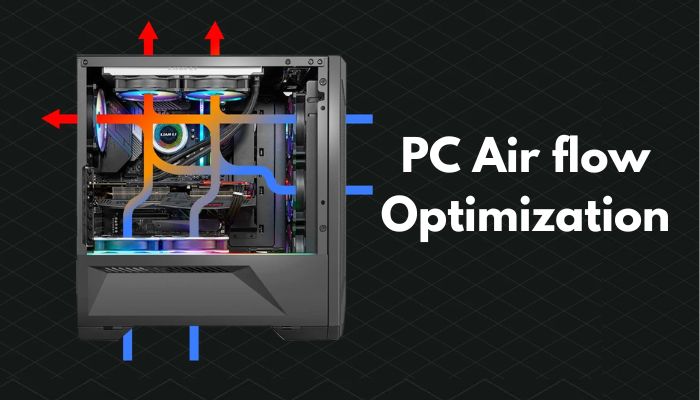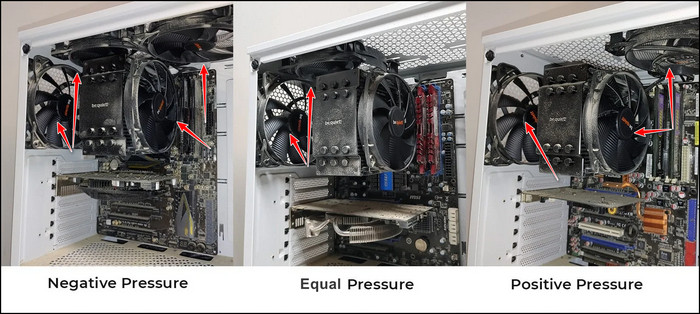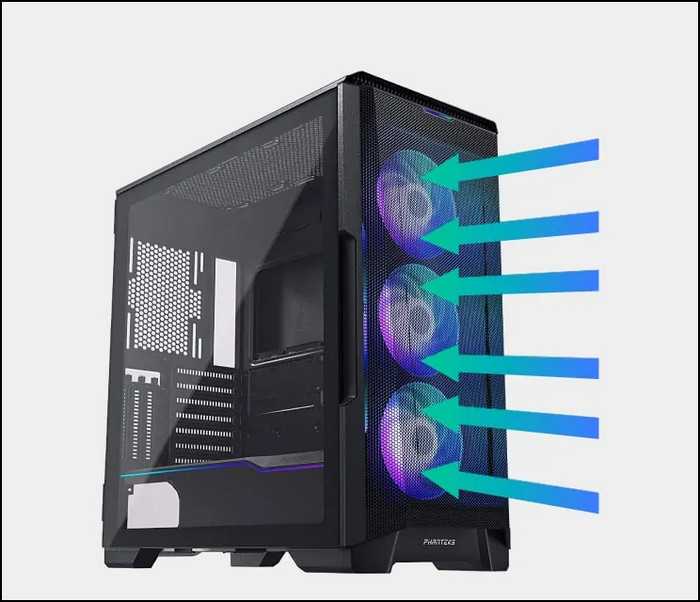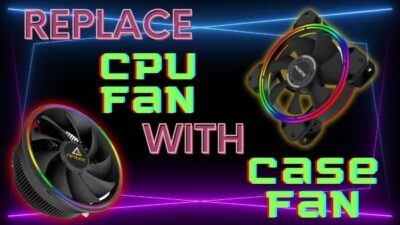Building a modern computer is remarkably easy nowadays. It is often considered LEGO for adults as computer components are modular now. However, air cooling management is way more complex.
Aside from the PC configuration, better airflow is a crucial factor in determining how a PC will perform. You may have top-of-the-line specs for your PC, but they will underperform if there isn’t any good airflow.
I believe you are already well informed about this. The thing that you don’t know is how to optimize the airflow of your system. Well, it’s complex but not rocket science.
There are a few basic principles that you can apply to get optimal airflow and excellent cooling. I’ll share those exclusive tips and tricks in this article.
Let’s begin the expedition.
Types of Airflow Configuration
Configuring the airflow is more important than having a better specification of hardware. Keeping the system cool and optimal is the most crucial job for a user. To optimize the airflow, you need to understand the airflow configuration.
There are three ways to configure a PC’s airflow. They are-
- Positive Air Pressure.
- Negative Air Pressure.
- Equal Air Pressure.
For better understanding, here are two types of fans that I will refer to:
- Exhaust Fan: This fan has its blowing side mounted to the wall of the case. And it blows the air outside after drawing air from inside. (Image reference…?
- Intake Fan: This fan has the blowing side facing toward the case. So it draws air from the outside and blows it inside. Image
Check our exclusive tutorial on Fix: PC won’t go to sleep mode in Windows 11.
Positive Air Pressure
Positive air pressure means the intake airflow is more significant than the exhaust airflow. Intake fans have a higher airflow rate compared to exhaust fans.
Even though having a positive air pressure inside the case is a good thing, excessive airflow isn’t good either. If you blow too much air inside the case with little exhaust airflow, you can find yourself in a place where the air gets stuck inside the case.
This stagnant air can get hot from the internal components and end up raising the temperature of the system.
Negative Air Pressure
Negative air pressure means the exhaust airflow is more prominent than the intake airflow. This configuration includes a higher exhaust airflow rate than the intake fans.
Though it is an effective system cooling option, it can often pull more dust into your system.
Adding filters is also more difficult for the intake areas as air may be drawn in where there is no place to add filters. However, in some uncommon situations, negative air pressure configuration doesn’t draw much dust into the system.
Here are the criteria to achieve this dust-free configuration:
- You must have a large intake area that is filtered.
- The filter must have the accurate size of pore and density.
- The filter has to have the proper cross-flow rate.
- Your computer case can’t have too many unfiltered intake areas.
Arguably, your system will remain clean for a longer period of time when the conditions above are present.
Follow our guide on how to Set Fan Curve on PC.
Equal Air Pressure
Equal air pressure is the balance between positive and negative air pressure. This is the best option that keeps the system both cool and clean.
As you have already known that a positive airflow configuration has better air filtration, you can add a standard filter to achieve a more dust-free environment.
As long as the airflow is balanced, plenty of air will flow in and out easily. That leads to a very minimum chance of stagnant air moving around the system, and your system will have an optimal temperature.
How to Optimize the PC Airflow
Airflow optimization depends on various factors such as fan configuration, fan speed control, air filters, less hindrance of airflow, etc. There are some simple steps that you can take to optimize the airflow system of your computer.
Here are the methods to optimize the PC airflow:
1. Configure Your PC Fans
First of all, take a look at the fans that your system currently has. Note down the number of intake and exhaust fans.
In case there is any fan that is causing noise, try disconnecting and cleaning it. If the noise persists, replace the faulty fans.
So, let’s get started by getting the latest Fix Oculus Quest 2 not Detected to PC.
Evaluate the Number of Fans You Need
The size of your computer determines how many fans you are able to install. You should install two to three intake fans on the front side and one exhaust fan for mid-tower cases.
If you have a larger full tower case, using three intake fans in the front and one big exhaust fan on the back side is a good starting point. You can add more fans to the system as it has that space to fit in. So having three fans is a minimum for full tower cases, and I recommend it as well.
Try to pick the larger type of fans because they will provide you with a quieter system down to the road.
In some cases, extra fans on the upper rear of the case help the CPU cool more efficiently. Not all cases have the option to mount fans at the top, so getting a case with the feature is an extra addition to cooling.
Choose the Perfect Fan SIzes for Your Computer
It is quite important to choose the perfect fan size for any system. Because any fan size mismatch causes your system to overheat and accumulate additional dust.
Here is a table that includes fan size and mounting size:
| Fan Cage Size | Between Mounting Holes |
|---|---|
| 40 mm | 32 mm |
| 50 mm | 40 mm |
| 60 mm | 50 mm |
| 70 mm | 60 mm |
| 80 mm | 71.5 mm |
| 92 mm | 82.5 mm |
| 120 mm | 105 mm |
| 140 mm | 124.5 mm |
| 200 mm | 154 mm |
| 220 mm | 170 mm |
2. Configure the Fan Control Speeds
There are several ways to control fan speeds. A large number of manufacturers offer a wide range of products to accomplish this.
As long as you are planning to set up the fans and forget about them, simply connecting them to the pin header on the motherboard will do the job. However, most BIOS supports fan speed adjustment. It adjusts the speed curve or allows full automation on the fan speed when it’s needed.
You can get the temperature reading by using temperature sensors. In case, if your BIOS doesn’t offer configurable features you can use third-party applications to adjust the fan speed.
You can even control each fan individually. For that, you need a module where all the fans will connect and the module will also connect to the power supply. This module allows each fan to adjust its speed according to the temperature reading.
More expensive models have a firmware package that can accept configurable profiles to automatically adjust the fans after reading the temperature.
3. Test the Airflow in Your Computer Case
The best way to determine the airflow level is by removing the PC case lid. Then you can see how much air is coming from the intake and exhaust fans.
Some fans with a poor design seem like spinning and doing their job but actually, their airflow can be poor. I don’t recommend those fans as they are not ideal and you should replace them right away. This is a common scenario when you buy and install extremely cheap fans.
You can use a fog blaster to check the airflow of your system. You can get it from the toy or hobby store.
You can take the airflow checking to another level by using airflow meters. All you need to do is, place the meters in various places and monitor how good the airflow is.
Also, check out our separate post on Fix Mass Effect Legendary Edition PC.
4. Check the Air Filters
Check the filters on your case to see how thick the filters are. As long as they are thick there is a high possibility that the airflow gets hampered.
On the other hand, when the filter has large pores or the filter is too thin, dust is easily going to be drawn into your machine. This will make heatsinks, fans, and your system dirty easily.
So get air filters that are good at filtration and easy to clean.
Follow our guide on How Much Energy Does a Gaming PC Use.
5. Maintain Obstruction-Free Airflow
You need to clear the path where the exhaust fans are situated. You can easily check whether the airflow is facing obstruction or not just by looking at the exhaust fan area.
Make sure to keep the inside of the case always tidy and free-flowing, because cables can easily cause airflow issues.
A very common scenario is the unused power supply cables that often tie in a bunch. These tied cables are enough to obstruct the airflow. You need to keep the cable management as tidy as possible.
Wrapping up
There you go! Hopefully, you get all the information and the methods to optimize the airflow of your computer. Just follow those methods and achieve a superbly optimized airflow system on your PC.
Thanks for reading this article. You can always leave comments about any queries. I will be more than happy to help you with that.
Peace!




